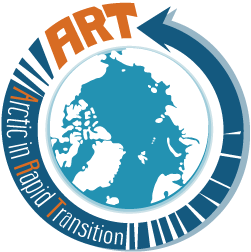|
|
|
Parallel sessionsIn addition to the plenary sessions (tuesday and friday morning), parallel sessions will be held on tuesday afternoon, wednesday morning, thursday morning and afternoon. The 3 first ones will consist on presentation of 5 to 15 minutes, based on submitted abstracts. The last session of thursday afternoon will be a group discussion in order to elaborate the priority sheets.
Session 1: Sea Ice in the Arctic Ocean: from microphysics to large scale dynamics (Chair: Angelika Renner, Co-chairs: Alexey Pavlov and Matthieu Chevallier) The Arctic sea ice cover is undergoing rapid changes which are most obvious in the reduction of sea ice extent, area and thickness observed in the last years. With increasing pressure on the Arctic in form of exploitation, shipping, and fishery activities, reliable forecasting of sea ice conditions both seasonally and longer term is becoming more and more important. However, sea ice remains notoriously difficult to model due to the complex nature of its physics, the interactions with atmosphere and ocean, and the various scales involved from ice crystals to Arctic-wide dynamics. In this session, we invite contributions addressing the full range of spatial (and temporal) scales with focus but not limited to the following topics:
Session 4: Marine biodiversity (Chair: B Bluhm, Co-chairs: M. Kedra and S. Majaneva) The polar regions have recently received a lot of scientific attention, yet our knowledge of the unique diversity of Arctic marine life forms has still major gaps. Extreme seasonality, presence of sea ice cover and low temperatures make the Arctic Ocean one of the most extreme environments, yet Arctic seas are holding a variety of unique life forms, highly adapted to the harsh conditions. Moreover, the Arctic Ocean is the area where the ongoing climate change and its effects appear to be expressed the strongest causing a large threat to Arctic biodiversity. The already ongoing changes make the effort to identify the diversity of Arctic marine life an urgent issue. Marine Biodiversity session will mainly aim to discuss in more detail the state of current knowledge and challenges associated challenges of changing Arctic for the diversity of marine life forms.
Session 5: Paleo-reconstruction and biological archives: decade to millenium (Chair: K. Hendry, Co-chairs: K. Werner and M. O'Regan) Reconstructions of the past climate and oceanographic variability in the Arctic significantly contribute to an improved understanding of the long-term feedback mechanisms in the Arctic Ocean and their relationship to global change. Arctic climate excursions during the present (Holocene) and earlier interglacials are an important reference for recent and future climate changes.
Session 6: Land-Ocean interactions: from coastal to submarine permafrost including gas hydrates (Chair: M. Grigoriev, Co-chairs: M. Fritz and D. Mercier) About one third of the Earth's coasts are affected by permafrost and the Arctic Ocean is almost entirely surrounded by permafrost coasts. Erosion of these coasts with maximum retreat rates of more than 20 meter per year delivers huge amounts of sediments, organic carbon and nutrients to the arctic nearshore zone. Submarine permafrost that is relict terrestrial permafrost occurs on the wide and shallow artic shelves that have been submerged since the postglacial sea level rise. Large methane hydrate reservoirs are contained within permafrost and underneath. Accelerated permafrost degradation onshore and offshore might lead to enhanced coastal erosion, increased material mobilization and the more rapid conversion of carbon into greenhouse gases. This session raises the following questions to work on:
Session 8: The responses of law and economics in a changing Arctic (Chair: A. Cudennec, Co-chairs: M. Jacquot and M. Mansoz) 1) In a changing Arctic what kind of institutional and legal responses exist to the rise of new issues such as the appearance of increased fisheries or the rise of navigation thanks to the opening of new routes in this area? Moreover, what are the links between scientific research in the Arctic and the elaboration of normative policies?
Session 2-3-7: Oceanography – physics, atmospheric interactions, and biogeochemistry (Chairs: F. Cottier, M. Reigstand; Co-chairs: H. Findlay, P. Bougain, N. Morata, Q. Shao, R. Hindshaw, S. Rastrick) This session combines the previous three separate sessions: 2) Physics, 3) Biogeochemistry and 7) Ocean-atmosphere exchange, and ocean acidification.
The loss of sea ice in the Arctic is resulting in a new oceanographic regime. From the physical processes, flow of water masses, water mass characteristics, and circulation patterns, interaction with the atmosphere – both through physical atmospheric forcing on the ocean and through heat- and gas-exchange processes, to the biogeochemical cycling of carbon and nutrients resulting in shifts in primary and secondary production. These changing dynamics have repercussions on feedbacks to climate, ocean acidification and ecosystem structure and functioning. However, the spatial and temporal complexity of these oceanographic processes requires further investigation. This session will cover topics from: 1) How are the characteristics of the water masses and circulation patterns changing and what are the consequences? 4) How will ocean acidification and carbon cycling change, and what implications will hydrographic shifts and chemical composition of rivers have? 4) How do we scale up knowledge on marine biogeochemical and ecosystem function from localised studies to the whole Arctic? 5) How can we understand seasonal and annual variations from disparate observations? |


